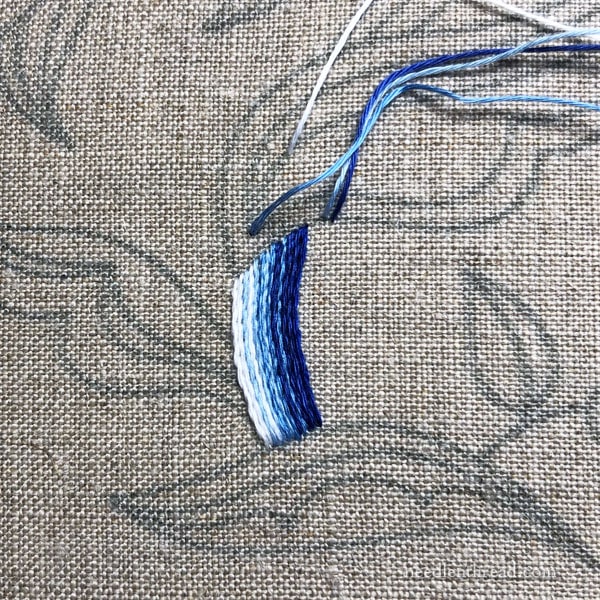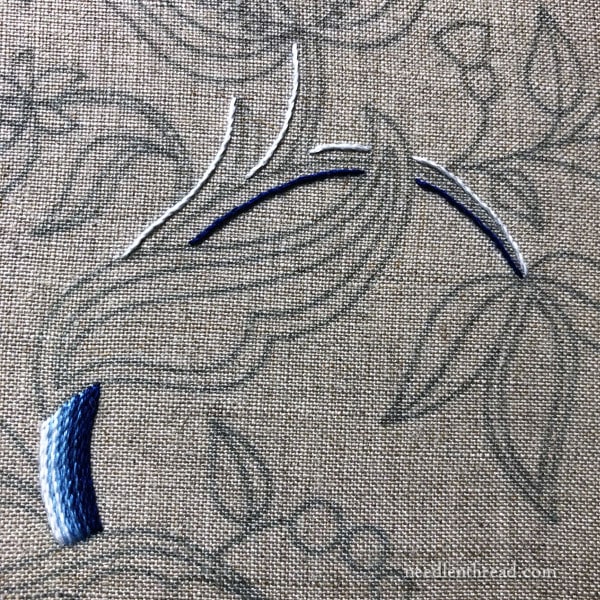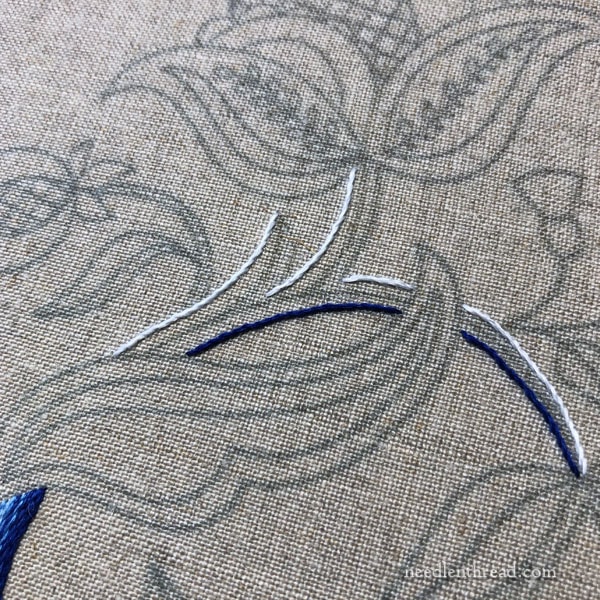Quite a while ago, we talked about this Jacobean-ish embroidery design that I keep toying with.
I set the design up on new fabric (a natural-colored linen), and collected threads for it.
Finally, the other day, I started some stitching on it.
Today, I’ll show you some minute initial progress as I work my way through the beginning of the project; I’ll tell you my thought processes; and we’ll talk about gradual shade and color changes when you’re working with solid colors in linear stitching.

I started with the trunk on the design, and my thought was that I’d like the trunk solidly filled with embroidery, not too textured, and gradually shaded.
I’m working with DMC Floche on this project (and I’ll also be mixing in some regular DMC cotton). Floche is about the weight of 1.5 – 2 single strands of DMC floss, when stitched.
I vaguely thought about using a raised stem stitch on the trunk, since I’ve seen that effectively done many times, but in fact, the floche is heavy already, and working it raised would really make the trunk – which is more of a background element – too hefty.
So I stuck with plain stem stitch.
The colors available in DMC floche are not extensive, so I don’t have super-smooth color transitions from the darkest blue to the white. In order to create the effect of a gradual shading, I worked the stem stitch in lines up the drunk, starting with the darkest blue and moving to the white, but striping them as I went.
So, in sequence, from right to left, with A being the darkest shade of blue and E being white, the colors go like this: one line of A, two lines of B, one line of C, one line of B, one line of C, two lines of D, one line of E, one line of D, two lines of E.

Up close, you can see the striped effect very distinctly, but even just a small distance back, the stripes are not as blatant and the colors blend from dark blue to white fairly well. Squint and pull back from your screen, and you’ll see what I mean. (Well, squinting might not be the best advice when you’re checking to see if something looks ok, but…)
To map out the rest of the journey on the trunk, I worked the outermost lines of each branch as they moved upward in the design.

This way, I’m sure that my edges are the right colors, and now I can fill between them, gauging the layout of the threads in a way that keeps a sense of shade change but still fits within the narrower trunk as it grows upwards.
It’s not a lot of progress, but at least it’s something. I’ve been a bit distracted with other projects that have a deadline, so I haven’t had much of a chance to even think about this particular embroidery project. But I keep it within eyesight, so that I don’t forget about it for too long!
As I work through this project, I’ll share thought processes, what works, what doesn’t, mistakes and corrections – until I hopefully bring it to a successful conclusion. It will be a slow developing project, though! Stay tuned for future updates!







Beautiful, Mary! Can’t wait to follow your progress on this! I just started one of the floral corner towels a few days ago, and guess what?! I’m doing it in blues! Inspired by my lovely Spode tea cups
It looks like something that will be really enjoyable to look at when it’s done – and highly interesting during it’s progress too! The darker linen makes the floss look so brilliant-toned. I love it so far!
I’m happy to see you back at this project. I can’t wait to see your progress as I love this style and color combo.
The colors are really pretty in this. I am wondering, though, how one gets a pattern onto a dark toned fabric. Navy blue, for example, or black. Is a white marking pencil the answer?
Yes, usually. A lighter colored pouncing powder works well, and then “connect the dots” with a white tailor’s pencil or even a fine-tipped white gel pen.
Dear Mary
Lovely Mary the blue really shows against the dark linen and as you progress on this project I’m sure the blue thread will look lovely looking forward to your progress on this project. Perhaps you can adopt the 15 minute stitching when you have time with this project which will keep the project going. Thanks for sharing with us your progress on the Jacobean Blues project and I hope you are able to get the other projects done in time for the deadline.
Regards Anita Simmance
The colors of the floche remind me of Dutch Delft painting. I’m excited to see the progress on this project.
I knew I’d be persuaded by the blues once I saw how you would use them! I love the way you have blended the shades – very simple but oh so effective.
I’m looking forward to seeing more of this design. It’s a pity more colors aren’t available in floche, but then 2 things keep popping in my head. First, Jacobean embroidery didn’t seem to be too stuck on being realistic. Second, being done in all blues, there’s no way it would be realistic no matter what style. So, not being perfectly shaded colors fits right in.
What is a good source for cotton batiste, in the U.S.? I have a project that I think could use a backing. I’m finding lots of places with poly-cotton or all polyester, but 100% cotton is hiding from me. Thanks!
Hi, Gail – you don’t need to use batiste for backing, if you don’t have it. A cheap (100% cotton) muslin will do the job! That said, I probably got mine from Farmhouse Fabrics or somewhere like that. I wouldn’t pay an arm and a leg for it – regular cotton muslin from the local fabric shop works just fine, and it doesn’t have to be the expensive stuff!